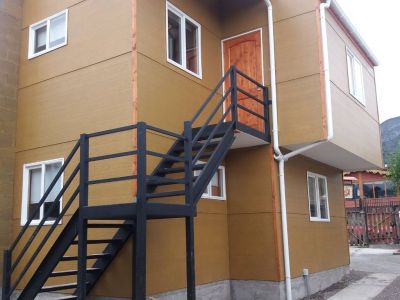The Simpson River valley is one of the main attractions in the outskirts of the City of Coyhaique and that was our destination as we felt curiosity to see the sequence of lakes and lagoons that were formed among this mountain range scenery thousands of years ago. As we set out from Coyhaique following the Southern Road towards the South, we caught a clear glimpse of the Simpson River: plentiful and going across a green residential area with evidence of great fertility. We made ourselves comfortable in our seats ready to see what was next. Near the cemetery, we arrived at a roundabout where we turned left. A sign guided us towards Lake Atravesado. The road was made of gravel and, as this is an open area with scarce vegetation, we could find out magnificent mountains in the background. We felt as if we had the size of a mosquito as we stood before the immensity of this place. It was logical that such an open area would be windy. But the weather was quite favorable and we did not pay much attention to that small detail.
The Green Crystal of Lake Atravesado
We came across sown fields and many cows pasturing. In the distance, we spotted some settlers, all of them devoted to their daily rural tasks. As we reached a cascade, we parked the car and walked around within an environment teeming with ferns and huge flowers. The vegetation is the result of the high humidity in the surroundings. It was then when the beautiful pastoral town of Villa Lago Atravesado appeared before us. Few permanent dwellers devoted to rural tasks, a school, lodging and a store to get supplies. That was all.
At a Slow Pace
We continued along the same road with plenty of vegetation to both sides and, as we crossed a bridge, we saw another small lake, namely the CEA. There was a primitive campsite without services and a beach where sailing and fishing boats were waiting to set sail. It was a very windy place. A little farther ahead, we reached our final destination: Lake Atravesado. We bordered it along its longest margin and watched the houses built on the hillsides with their own piers. It was a fantastic and quiet location indeed. We made a stop to behold the scenery and we realized silence was almost absolute. Our own voices and the sounds made by some birds spotting our presence were all we could hear. We intended to go down towards the lake and find some beach to spend the afternoon. It was not until the end of the tour and almost by accident that we found a trail leading to the shore. Had we not paid careful attention, we would have missed the opportunity of enjoying the beach. Once there, the wind was gone and it was sunny. We had a short rest and breathed in the aroma of the vegetation and enjoyed the almost imperceptible sound of the water bathing the coast. Afterwards, we continued the circuit towards Lagunas valley and a high waterfall crowned our visit. A fine drizzle reached us from the heights and we let us fall over our heads as a way of refreshing ourselves. Several families of peasants were carrying their animals to another area and we noticed that there was much firewood in the surroundings as a result of the snowfalls and winter winds maybe. A new crossroad led us to Lake Patrón. Dense forests, lianas among the trees formed a particular kind of weaving. There were more cascades and viewpoints from where we could have a look at the mountains. During the entire tour, we tried to store the experience in our memories. Maybe it would be worth returning to this place and going on a mountain bike or a horse ride in the future. We made a commitment to fulfill this task in order to get to know this wonderful lake scenery more deeply. As we returned home, the photographs taken during the tour ended up as the wallpaper in our computer. We wished to revive those delightful postcards caught in Southern Chile. Mónica Pons
Eduardo Epifanio
It is essential to have a good map of the area, as some forks are not properly sign-posted.






























